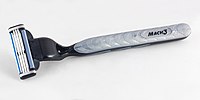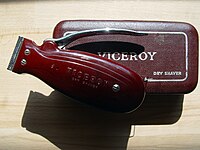Razor

A Gillette Mach3 razor
|
|

Spring-loaded Viceroy dry shaver made by Rolls Razor
|
|
A razor is a bladed tool primarily used in the removal of unwanted body hair through the act of shaving. Kinds of razors include straight razors, disposable razor, and electric razors.
While the razor has been in existence since before the Bronze Age (the oldest razor-like object has been dated to 18,000 B.C.), the most common type of razor in current usage is the safety or electric razor, though other kinds are still in use.
Razors have been identified from many Bronze Age cultures. These were made of bronze or obsidian and were generally oval in shape, with a small tang protruding from one of the short ends.
Various forms of razors were used throughout history, which are different in appearance but similar in use to modern straight razors. In prehistoric times clam shells, shark teeth, and flint were sharpened and used to shave with. Drawings of such blades were found in prehistoric caves. Some tribes still use blades made of flint to this day. Excavations in Egypt have unearthed solid gold and copper razors in tombs dating back to the 4th millennium BC. Several razors as well as other personal hygiene artifacts were recovered from Bronze Age burials in northern Europe and are believed to belong to high status individuals. The Roman historian Livy reported that the razor was introduced in ancient Rome in the 6th century BC. by legendary king Lucius Tarquinius Priscus. Priscus was ahead of his time because razors did not come to general use until a century later.
The first modern straight razor complete with decorated handles and hollow ground blades was constructed in Sheffield, in England, the centre of the cutlery industry, in the 18th and 19th centuries. Benjamin Huntsman produced the first superior hard steel grade, through a special crucible process, suitable for use as blade material in 1740, though it was first rejected in England. Huntsman's process was adopted by the French sometime later; albeit reluctantly at first because of nationalist sentiments. The English manufacturers were even more reluctant than the French to adopt the process and only did so after they saw its success in France. Sheffield steel, a highly polished steel, also known as Sheffield silver steel and famous for its deep gloss finish, is considered a superior quality steel and is still used to this day in France by such manufacturers as Thiers Issard.
...
Wikipedia
